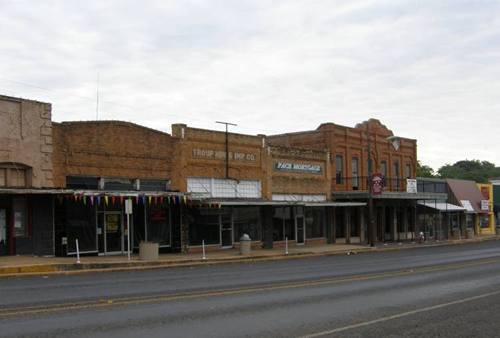|
|
TROUP, TEXAS
Smith
County, East Texas
32°8'40"N 95°7'12"W (32.144382, -95.120018)
FMs 13, 15, 346, and 347 and
Highways 110 and 135
18 Miles SE of Tyler
17 miles NE of Jacksonville
Population: 1,982 Est. (2016)
1,869 (2010) 1,949 (2000) 1,659 (1990)
Book Hotel Here › Tyler
Hotels |
 |
History in
a Pecan Shell
The area had been settled prior to 1850 but no development
occured until the arrival of the railroad
in the early 1870s when the Houston and Great Northern appeared. The
town was platted where the railroad's
mainline continued to Longview
while a branch extended to Tyler.
A post office under the name of Zavala opened in 1873 but was
changed to Troup in 1877. The 1892 population was 600 with
all essential businesses including several millinery stores. It doubled
by 1902 to 1,200 citizens. By the end of the 1920s, Troup had 1,800
people. The town was spared the brunt of the Great Depression by becoming
an important location for the East
Texas oil boom.
Troup had 75 businesses in the mid 1930s and ended that decade with
a population of 3,000. Increased mobility after WWII
reduced the population by half.
New Hope, Salem, and Prairie Lee schools merged with the Troup ISD
in the early 50s. The 1981 population was given as 1,911 and for the
2000 population it was 1,949. |
Troup, Texas
Landmarks / Photo Gallery
Photos courtesy
Barclay
Gibson, July 2007 |
| First Presbyterian
Church |
 |
 |
 |
Historical Marker:
junction of N. Georgia and McKay St.
Troup City
Cemetery
This community
burial ground originally served the early settlers of Zavala, later
known as Troup, a town established along a line of the International
& Great Northern Railroad in 1873. Since no land was set aside for
a public cemetery when the town was platted, efforts were made to
secure a tract from the railroad. As a result of the influence of
city leaders, prominent local residents, and Judge William Wright
Morris, the area representative to the Texas Legislature, the railroad
provided 1.67 acres of land at this site in 1875 for a burial ground,
known then as Zavala City Cemetery.
The earliest known grave is that of South Carolina native William
A. Arms. Originally buried in New Orleans, he was reinterred here
in the 1870s by his widow Martha Ann (Walker) Arms and his son Marion
Francis Arms. Also buried here are three early mayors of the city,
Dr. Erasmus Manley Hanna, William Clark Spruce, and Judge Stephen
Decatur Morris. Leaders in securing the first rail line to the area,
they were instrumental in having this site set aside for use as
a public cemetery. Other graves here include those of prominent
local residents and community leaders who contributed to the development
of the area.
1981
|
| Texas
Escapes, in its purpose to preserve historic, endangered and vanishing
Texas, asks that anyone wishing to share their local history, stories,
landmarks and vintage/historic photos, please contact
us. |
|
|

 Texas
Gulf Coast
Texas
Gulf Coast East
Texas
East
Texas Central
Texas North
Central
Texas North Central
Texas South
Central
Texas South Texas
Panhandle
Texas
Panhandle South
Texas
South
Texas Texas
Hill Country
Texas
Hill Country West
Texas
West
Texas Texas
Ghost Towns
Texas
Ghost Towns Texas
Counties
Texas
Counties